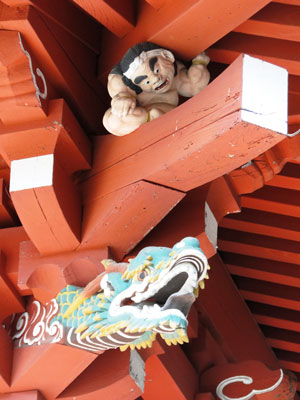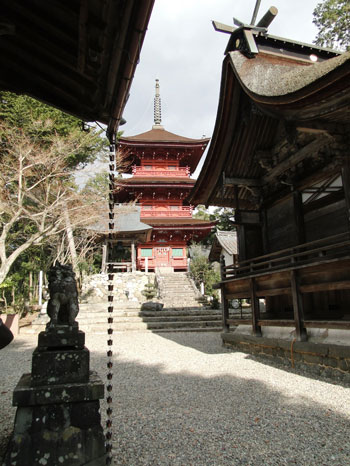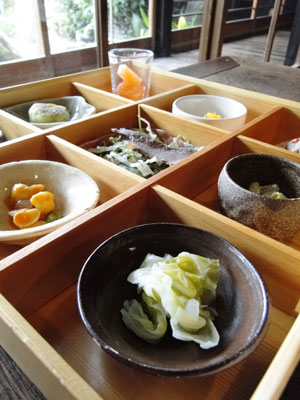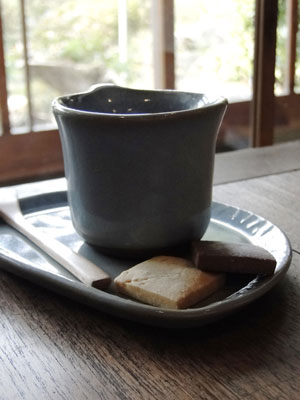JAPAN SHOWCASE|Great Tamba area
Ancient hilltop shrine, venison highlight trip to Kaibara
The path to the top of the hill in Kaibara town is shaded by maple trees, still fiery in their demise so late in the season. The smooth stone steps turn once, twice, before petering out just before a large torii gate. Beyond this wooden marker lies the Kaibara Hachimangu Shrine, the oldest shrine in the Tamba region, an area of low peaks and fertile valleys in the northern part of HyogoPrefecture. From behind the main hall, the low reverberation of a bell echoes across the valley. When the last thrum dies away, the only remaining sound is the rustle of the wind through the precinct of this 1,000-year-old shrine.

As the main Iwashimizu Hachimangu Shrine near the city of Kyoto — dedicated to the protection of the Imperial family — grew in importance in the 11th century, the decision was made to establish a branch temple in Kaibara as well. Construction was completed in 1024 and the shrine's popularity rose considerably over the years. Victim of the rampant fighting during the Warring States Period (late -15th to late 17th century), the shrine was repaired at the direction of Nobunaga's successor, Toyotomi Hideyoshi.
Today, it's a quiet locale, except in early February when Kaibara's priests host Japan's oldest festival for warding off evil. In any season, though, a wander through the grounds is highly rewarding. Red-tinged maples bend their branches low over a line of polished stone lanterns. Colorful ema (prayer plaques) display the typical zodiac animals as well as scenes from local stories, including the legend of Nasu no Yoichi, an archer whose prowess in the Gempei War netted him a castle in neighboring TottoriPrefecture.
In the back of the precinct, a five-story pagoda towers over the hilltop complex. While Shintoism and Buddhism coexist peacefully in Japan, rare is the case where their buildings inhabit the same grounds. Only 18 shrines in all of Japan record a Buddhist pagoda on the premises; in Kaibara's case, an ornate pagoda has stood here for almost exactly 200 years. Recent coats of paint have spruced the structure up, and observant visitors will enjoy the host of phoenix, dragons and even carved humans that adorn the facade.

In the parking area below the shrine, a small morning market offers up the last of autumn's bounty — mushrooms, pumpkins, turnips and the ever-present daikon. One enterprising vendor sells freshly made mochi (glutinous rice cakes), a popular New Year's food. Steps away from the commerce is the Kinone Bridge (kinone bashi), a 1,000-year-old zelkova tree whose roots grew across the town's Okumura river and formed an improvised walkway. Though it is now crowned by a vermillion bridge as well, the tree's prodigious roots can still be seen under the wooden supports of the newer construction.
Not far from the bridge, a massive entrance gate and carefully raked grounds are all that remain of the once impressive residence of the Oda family, daimyo (lords) of the Tamba region for generations. Nearby, a green noren (hanging curtain) flaps gently in the noontime breeze over the door of a relatively nondescript building. The outline of a deer on the forest-colored cloth is the only indication that inside lies Japan's only restaurant specializing exclusively in venison.
Mujika may have only been on the culinary scene for a short while (it opened in 2010, though the building is over a century old), but it's determined to make a splash in an already food-focused nation. The menu is centered around various preparations of deer, with the meat coming exclusively from the Tamba region. Vegetables are hand-picked by the chef from local suppliers, ensuring a highly seasonal approach to the ever-changing menu.

A large, wood-paneled dining area promises a cozy atmosphere for lunch, but our party is lucky enough to be led to one of the restaurant's private tatami rooms. We slip off our footwear on the polished engawa (veranda) and settle onto cushions around a communal table. The server leaves the sliding door open so we can admire the building's lovingly tended interior garden.
You can order a la carte, but a number of set menus are on offer as well, giving diners the chance to taste deer in many forms. We choose the basic lunch course (¥1,680) and within no time, our appetizer — and the highlight of the menu, in my opinion — is placed before us. Nine tiny dishes nestle inside a wooden bento box, boasting two- to three-bite morsels of delicacies such as a salad of persimmon and Chinese cabbage, roasted pumpkin with a maple glaze and a small serving of carrot jelly. Three of the dishes feature deer in differing preparations — a venison pate topped with pink pepper grains, venison stewed in tomato sauce and a simple slice of perfectly cooked deer that highlights why this cuisine deserves every accolade it has received.
The main course is no less delicious, with slices of deer meat in a sansho and miso sauce served over a slice of locally grown kabotcha pumpkin. A hearty bowl of rice and the obligatory plate of pickles end the meal, and I have just enough room for the tiny cookie that accompanies our final coffee.

When someone jokingly asks what part of the deer is in our shortbread, the waiter smiles.
“Deer bones, actually,” he says, clearly relishing the surprise on our faces. Long believed by practitioners of Chinese medicine to have healing qualities, trace amounts of ground deer bone are added to Mujika's shikakui cookies. Lest you have a craving — or need — for these quite normal tasting cookies later on, the restaurant sells them prepackaged for takeaway as well. And if you haven't quite had your fill of all things deer-related, a visit to the restaurant's facilities with their antler-tipped toilet paper stands is sure to leave you with a smile.
Kaibara may not look like much on the map, but it's the kind of town that surprises you. With an atmospheric hilltop shrine, a walkable city center and a restaurant that will have you wishing venison was a staple food, a visit here will be long remembered.




